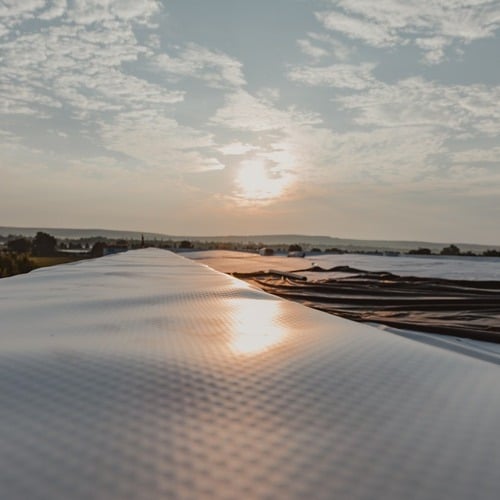- Open 24/7
- 13611 E 104th Ave Henderson, CO
Golden way Roofing

TPO roofing, or Thermoplastic Polyolefin, is a popular single-ply roofing membrane used in commercial and residential properties. It is known for its durability and cost-effectiveness, making it a preferred choice for many building owners.
TPO roofing comprises a single layer of synthetics and reinforcing scrim covering flat roofs. It is manufactured in sheets of varying widths and is then rolled out and installed on the roof. TPO has gained industry acceptance, with the National Roofing Contractors Association reporting that it holds about 40% of the commercial roofing market share.
When considering roofing options, TPO roofing systems offer a range of benefits. From easy installation to long-lasting durability, TPO roofs are cost-effective for commercial and residential properties.
Investing in TPO roof installation can provide long-term savings, as they are energy-efficient and require minimal maintenance. The reflective surface of TPO roofing helps to reduce energy consumption by reflecting UV rays and heat from the building, resulting in lower cooling costs during hot summer months.
Over time, TPO roofs may experience wear and tear, requiring occasional repairs and maintenance. Some common signs that a TPO roof may need attention include water leakage into the building, seam failure, and punctures in the roofing membrane. When these issues arise, contacting a professional commercial roofing contractor is crucial.
A thorough inspection by a commercial roofing expert is the first step in assessing the extent of the damage and determining the necessary repairs. During the inspection, the contractor will evaluate the seams’ condition and check the insulation’s saturation level. Based on these findings, they can accurately estimate the repair costs and recommend the most suitable course of action.
TPO roof maintenance is essential for maximizing the lifespan of the roofing system. Regular inspections should be conducted to identify any potential issues early on. This includes checking for signs of damage, such as cracks, blisters, or loose seams. Additionally, periodic cleaning and debris removal are recommended to prevent clogged drains and potential water pooling.
The TPO roofing process typically involves the installation of TPO roofing membranes, which are available in sheets of various sizes. These membranes are applied to the roof surface using specialized adhesives or mechanically fastened. The bright white color of TPO roofing not only enhances the aesthetic appeal of the building but also helps reflect UV rays and heat, reducing energy consumption.
During TPO roofing installation, it is essential to follow best practices to ensure a proper and long-lasting installation. This includes adequate surface preparation, accurate measurement and cutting of the TPO roofing membrane, and effective sealing of seams and edges. Hiring a professional contractor with experience in TPO roofing installation can help ensure a smooth and successful installation process.
TPO roofing, or Thermoplastic Polyolefin, is a single-ply roofing membrane comprising a single layer of synthetics and reinforcing scrim. It is used to cover flat roofs in both commercial and residential properties.
Signs that a TPO roof may need repair include water entering the building, seam failure, and membrane punctures.
The first step is to call a commercial roofing contractor for a thorough inspection. They will determine the extent of the damage, the seams’ condition, and the insulation’s saturation level.
TPO roofing offers several advantages, including its bright white color and reflective surface that help reduce energy consumption by reflecting UV rays and heat. TPO membranes are also Class A fire-rated.
TPO roofing is made of thermoplastic polyolefin, combining polypropylene and ethylene-propylene rubber. It is available in sheets of various sizes and is known for its ability to resist weather, UV rays, heat, and oxidation.
Yes, homeowners insurance typically covers hail damage to an EPDM membrane roof, but it’s important to check your specific policy for coverage details.
The cost of spray foam roofing and TPO per square foot can vary widely depending on factors such as location, roof complexity, and contractor, but generally ranges from $4 to $7 for TPO and $3 to $6 for spray foam roofing.
A TPO roof refers to a roofing system made from Thermoplastic Polyolefin, a single-ply roofing membrane known for its durability and heat-reflective properties. TPO roof coating is a protective layer applied to a TPO roof to enhance its UV resistance and longevity.
A PVC roofing membrane is a type of single-ply roofing material made from polyvinyl chloride, known for its strength, durability, and resistance to chemicals and UV light.
A typical TPO roof can cost between $5 and $9 per square foot installed, depending on the specifics of the roofing project such as roof size and installation complexity.
The cost of a TPO roofing system for a commercial property can range widely, typically between $5.50 and $10 per square foot, influenced by factors like roof design and contractor selection.
The main difference between PVC and TPO roofing lies in their chemical composition and performance characteristics. PVC is more resistant to chemical exposure, while TPO offers better energy efficiency and heat resistance.
With a TPO roof, you have several insulation options including polyiso, EPS, and XPS, each providing different levels of thermal resistance and moisture protection.
TPO roofing lowers energy costs by reflecting UV rays and reducing the need for air conditioning, thanks to its high solar reflectivity and thermal emittance properties.
TPO roofing is a type of thermoplastic polyolefin single-ply roofing membrane known for its heat-reflective properties and strong resistance to ultraviolet, ozone, and chemical exposure. It differs from other materials by providing a balance of performance and cost-effectiveness.
The disadvantages of TPO roofing include variability in quality between manufacturers, sensitivity to high heat, and a shorter lifespan than some other commercial roofing materials.
Golden way Roofing
© 2024 All rights Reserved. Golden Way Roofing | Powered by Casey’s SEO